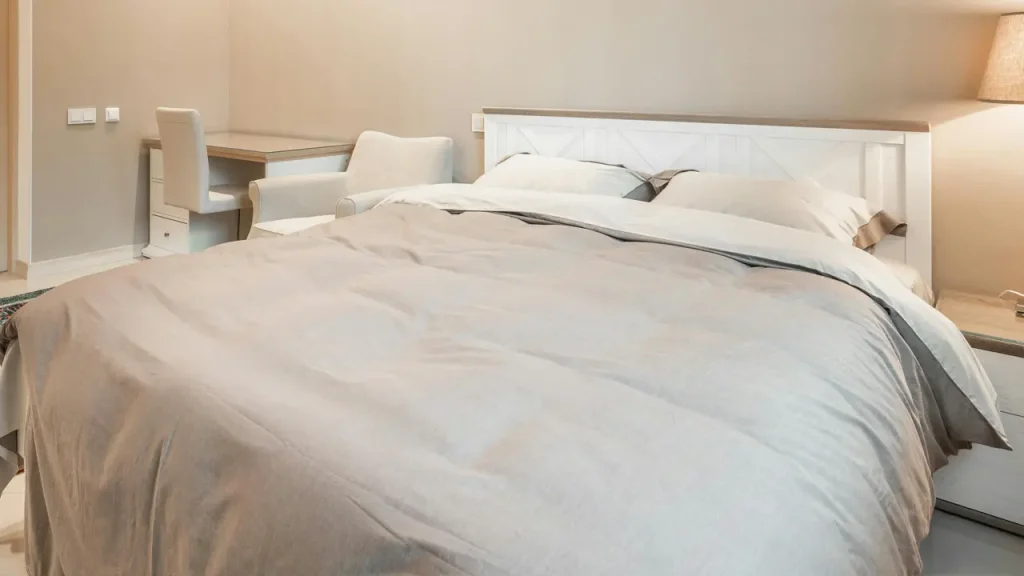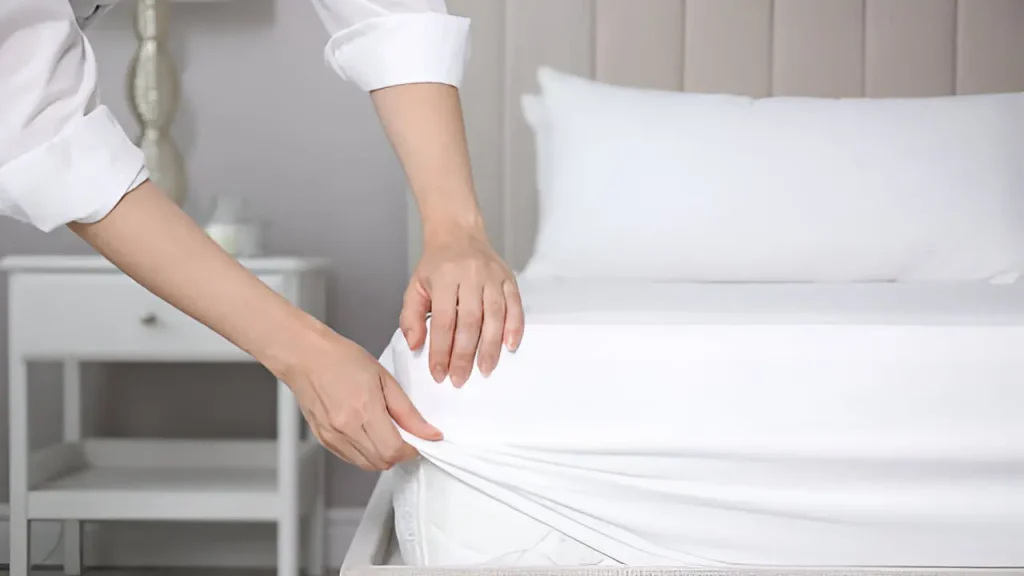Guide to Duvet Cover & How Does It Differ From Other Bedding?

The cozy corner of my world where comfort meets style—today, we’re diving into the transformative power of the duvet cover. As a seasoned interior designer, I’ve seen firsthand how the simple act of changing a duvet cover can breathe new life into a bedroom.
It’s not just about keeping your bedding fresh; it’s about expressing yourself, embracing change, and curating comfort. Whether you’re looking to refresh your space with a splash of color or aiming for understated elegance, the right duvet cover is your secret weapon. Let’s unravel the art of selecting the perfect duvet cover to elevate your sleeping sanctuary.
What Is a Duvet?
Imagine yourself stepping into a tranquil, cozy bedroom after a long day. The centerpiece of this serene sanctuary is the bed, draped with a soft, plush covering that invites you to dive in and forget the world. This covering, my dear reader, is known as a duvet.
Originating from Europe, a duvet is essentially a soft, flat bag filled with down, feathers, wool, or a synthetic alternative. It’s designed to serve as the top layer of bedding, combining the warmth of a comforter with the simplicity of a single covering. Unlike traditional comforters, duvets are typically white or off-white and are meant to be used with a protective cover.
The beauty of a duvet lies in its simplicity and its functionality. It’s like a cloud resting on your bed; light, warm, and incredibly inviting. The duvet is unique because it’s easier to maintain than other bedding forms—simply remove the duvet cover and launder it, rather than washing the entire piece. This not only makes it practical but also allows for quick changes in your bedroom’s decor style.
What Is a Duvet Cover?
A duvet cover functions much like a pillowcase for your duvet. It is a removable layer that not only protects the duvet from dirt, spills, and wear but also allows you to transform the style of your bedding with ease. Just as you might change a pillow cover, switching out a duvet cover can refresh your bedroom’s look without the need to invest in a new duvet.
Crafted from various materials such as cotton, linen, polyester, or blends, duvet covers come in an endless array of patterns, colors, and textures. This versatility makes it easy to adapt your bedding to suit seasonal decor or simply to match your mood. Whether you opt for a bold, graphic print to make a statement or a soft, pastel tone for a soothing ambiance, the duvet cover makes it possible.
The practicality of a duvet cover extends beyond aesthetics. It’s designed for easy maintenance, typically with features like buttons, zippers, or ties to secure it around the duvet. When it’s time for cleaning, you can simply strip off the cover and throw it into the washing machine. This not only keeps your duvet fresh but also reduces the need for frequent and often cumbersome laundering of the duvet itself.
What Are Duvet Covers Made Of?
The choice of material for a duvet cover is crucial, as it directly impacts your comfort, the longevity of the cover, and even the overall ambiance of your bedroom. Duvet covers are made from a variety of fabrics, each offering distinct benefits and aesthetic appeals. Let’s unwrap the layers of these materials to discover which might best suit your sleeping sanctuary.

Cotton
Cotton is a perennial favorite for bedding due to its breathability, softness, and durability. It’s hypoallergenic and gentle on the skin, making it an ideal choice for those with sensitive skin or allergies. Cotton duvet covers can range from basic and affordable to high-thread-count luxury options, providing a scale of options for comfort and style.
Linen
Linen, made from the fibers of the flax plant, offers a naturally rustic, textured look that becomes softer with each wash. It is extremely durable and even stronger when wet, making it long-lasting. Linen’s natural ability to regulate temperature helps keep you cool in the summer and warm in the winter, making it perfect for year-round use.
Polyester and Blends
Polyester duvet covers are often more affordable and offer significant durability and resistance to wrinkles and shrinkage. Blends, such as cotton-polyester, combine the best of both worlds, offering the comfort of cotton with the durability of polyester. These are particularly appealing for those who prioritize ease of care and longevity.
Silk
Silk duvet covers are the epitome of luxury. They are incredibly smooth, hypoallergenic, and good for both your skin and hair thanks to their natural proteins and amino acids. Silk’s thermal-regulating properties also make it an excellent choice for maintaining a comfortable sleeping temperature.
Bamboo
Bamboo duvet covers are gaining popularity due to their sustainability and the natural softness of the material. Bamboo is moisture-wicking, temperature-regulating, and naturally antibacterial, making it an excellent choice for those looking for eco-friendly bedding solutions.
What Is It Used For?
A duvet cover serves several practical and aesthetic functions in a home, making it an indispensable part of modern bedding for several reasons:

Protection
At its core, a duvet cover’s primary role is to protect the duvet inside from dirt, dust, oils, and wear and tear. Since duvets can be bulky and difficult to clean, the cover takes on the brunt of everyday use. By shielding the duvet, the cover extends its life and keeps it fresh and clean, reducing the need for frequent washing of the duvet itself.
Ease of Care
Duvet covers simplify the laundering process. Instead of washing the entire duvet, which can be cumbersome and often requires a commercial-size washing machine, you can easily remove the cover and wash it at home. This not only saves time and effort but also ensures that your bedding remains hygienic without the hassle.
Style and Decor
Duvet covers are fantastic tools for interior design. They allow you to change the look of your bedroom quickly and cost-effectively. With a variety of colors, patterns, and textures available, a duvet cover can be swapped out according to the season, mood, or current decor trends. This versatility makes it easy to keep your bedroom feeling fresh and stylish.
Comfort and Customization
Beyond aesthetics, duvet covers can be chosen to enhance comfort. Depending on the material, a cover can add warmth, manage moisture, or even cool the skin, which is particularly beneficial in climates with varying temperatures. The right duvet cover can significantly influence your comfort level, improving sleep quality.
Allergen Barrier
For allergy sufferers, duvet covers are essential. They act as a barrier to dust mites, pet dander, and other potential allergens that can accumulate in bedding. Regularly washing the duvet cover in hot water can help keep allergens at bay, providing a cleaner, healthier sleep environment.
The Pros and Cons of a Duvet
Duvets are a popular bedding choice for many, favored for their simplicity and comfort. However, like any home essential, they come with their own set of advantages and drawbacks. Understanding these can help you decide whether a duvet is the right choice for your bedding needs.
Pros of Using a Duvet
Versatility in Styling: Duvets allow for easy changes in bedroom decor. By simply switching the duvet cover, you can transform the look of your room without the need to buy new blankets or comforters for different seasons or styles.
Ease of Maintenance: Unlike traditional comforters that may require special cleaning methods, duvets are generally easier to maintain. You can wash the cover regularly without having to wash the duvet itself, which can be bulky and difficult to dry.
Comfort and Insulation: Duvets are designed to provide excellent thermal insulation. Depending on the filling, a duet can be used year-round, keeping you warm in winter and cool in summer, without the weight of multiple blankets.
Allergy Management: With the ability to frequently wash the cover, duvets can be more suitable for allergy sufferers. Keeping the duvet cover clean reduces exposure to allergens, providing a fresher sleeping environment.
Cons of Using a Duvet
Initial Cost: High-quality duvets can be an investment. The cost of a duvet plus a protective cover can be higher than that of a standard comforter or blanket, particularly if you opt for natural fill materials like down.
Complexity in Setup: Some people find putting a duvet cover on a duvet to be a challenging and frustrating process. The traditional “duvet shake” method can be cumbersome, especially with larger duvets.
Shifting of Filling: Depending on the construction, the filling inside a duvet can shift, leading to uneven insulation. This can require regular shaking or adjusting to ensure the filling is evenly distributed.
Size and Fit Issues: It can sometimes be difficult to find the perfect match between a duvet and its cover. Incorrect sizing can lead to a duvet that shifts within the cover or does not fill it out properly, affecting comfort and appearance.
Conclusion
In this post, we’ve explored the multifaceted world of duvet covers—from their practical benefits like ease of maintenance and versatility in style to the variety of materials available such as cotton, linen, and silk. We’ve uncovered how duvet covers not only protect your duvet but also offer an easy way to switch up your decor, reflecting your personal style and adapting to the changing seasons or your mood.
